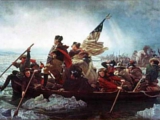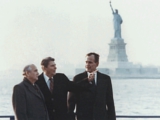Posts Tagged ‘us historical icons’
Monticello VA Thomas Jefferson Home
Monticello VA Thomas Jefferson Home
931 Thomas Jefferson Pkwy
Charlottesville, VA 22902

Monticello is a National Historic Landmark just outside Charlottesville, Virginia. It was the home and burial place of Thomas Jefferson, the principal author of the United States Declaration of Independence, 3rd President of the United States and founder of the University of Virginia.
The house, which Thomas Jefferson designed, was based on the neoclassical principles described in the books of the Italian Renaissance architect Andrea Palladio. It is situated on the summit of an 850′ peak in the Southwest Mountains. Its name means “Little Mountain.”
Monticello used to appear on the reverse side of the $2 bill, until it was replaced by an engraved modified reproduction of the Declaration of Independence.
Monticello, along with the nearby University of Virginia, also designed by Jefferson, was designated a UNESCO World Heritage Site in 1987.
Source: http://en.wikipedia.org/wiki/Monticello
US Historical Icons
US Historical Icons:
- Plymouth Rock, Pilgrim Memorial State Park
- Mount Vernon Memorial Park
- Liberty Bell, Independence Hall
- Valley Forge National Historical Park
- Monticello VA National Historical Landmark
- The Lewis and Clark Journey
- The Alamo
- Gettysburg National Military Park
- Little Big Horn
- Statue of Liberty
- Kittyhawk, NC
- Mt Rushmore National Memorial Park
- USS Arizona Memorial
- WTC Ground Zero Museum & Memorial
- Arlington National Cemetery
- Washington DC Monuments
- Kennedy Space Center
- The Great Seal of the United States of America
The Alamo - San Antonio, TX - Daughters of the Republic of Texas
The Alamo - San Antonio, TX - Daughters of the Republic of Texas
The Alamo
300 Alamo Plaza
San Antonio, TX 78205
(210) 225-1391
Open Mon-Sat 9am-5:30pm; Sun 10am-5:30pm

More than 2.5 million people a year visit “The Alamo.” They come to see the old mission where a small band of Texans held out for 13 days against the army of General Antonio LĂłpez de Santa Anna. Although the Alamo fell in the early morning hours of March 6, 1836, the death of the Alamo Defenders has come to symbolize courage and sacrifice for the cause of Liberty. The memories of James Bowie, David Crockett and William B. Travis are as powerful today as when the Texan Army under Sam Houston shouted “Remember the Alamo!” as it routed Santa Anna at the battle of San Jacinto on April 21, 1836. The Alamo has been managed by the Daughters of the Republic of Texas since 1905. Located on Alamo Plaza in downtown San Antonio, Texas, the Alamo represents nearly 300 years of history. Three buildings - the Shrine, Long Barrack Museum and Gift Museum - house exhibits on the Texas Revolution and Texas History. Visitors are welcome to stroll through the beautiful Alamo Gardens. Just a short distance from the River Walk, the Alamo is a “must see” for all who come to San Antonio.
Click here to Learn about the Battle of the Alamo
Source: http://www.thealamo.org/
Bowers Museum: Benjamin Franklin Exhibit
The story of America’s most dynamic forefather, Benjamin Franklin, told through rare artifacts and engaging interactive experiences.
Benjamin Franklin: In Search of a Better World Saturday, December 18 - Sunday, March 13, 2011
Featuring 75 rare and important artifacts from Ben Franklin’s life, this exhibition is an interactive visitor experience for all ages. The exhibition presents the stories of Benjamin Franklin’s life through his personal belongings used during his early years in Boston as a rebellious teenager, during his life as a printer and during his years of service to the American colonies and the newly formed United States of America. A scientist, inventor, diplomat, humorist, philanthropist and entrepreneur, Benjamin Franklin’s dynamic personality comes to life through hands-on and interactive activities and animations geared toward a school-aged audience.
Bowers Museum
2002 N Main Street
Santa Ana, CA 92706
(714) 567-3600
Open Tue-Sun 10am-4pm
More info:
http://www.benfranklinexhibit.org/
Bowers Museum Educator Workshop - Benjamin Franklin
Greatest American Entrepreneurs: Benjamin Franklin
Liberty Bell (Pass and Stow), Independence Hall, Philadelphia PA
Liberty Bell, Independence Hall: Philadelphia PA
500 Chestnut St
Philadelphia, PA 19106
Phone: 215-597-8787

The Declaration of Independence and US Constitution were signed at Independence Hall in Philadelphia, PA, in 1776. On July 8, 1776, the Liberty Bell, made by John Pass & John Stow (Pass and Stow) was rung to summon people for the reading of the Declaration of Independence.
It was cast in London, England. It cracked soon after it arrived in Philadelphia. Pass and Stow cast a new bell in 1753, using metal from the English bell. Their names appear on the front of the bell, along with the city and the date. By 1846 a thin crack began to affect the sound of the bell. The bell was repaired in 1846 and rang for a George Washington birthday celebration, but the bell cracked again and has not been rung since.
The bell weighs about 2000 pounds. It is made of 70% copper, 25% tin, and small amounts of lead, zinc, arsenic, gold and silver. It hangs from what is believed to be its original yoke, made from American elm, also known as slippery elm.
The Liberty Bell’s inscription conveys a message of liberty. In 1751, the Speaker of the Pennsylvania Assembly ordered a new bell for the State House. He asked that a Bible verse to be placed on the bell - “Proclaim LIBERTY throughout all the Land unto all the inhabitants thereof” (Leviticus 25:10). As the official bell of the Pennsylvania State House (today called Independence Hall) it rang many times for public announcements.
The old State House bell was first called the “Liberty Bell” by a group trying to outlaw slavery. These abolitionists remembered the words on the bell and, in the 1830s, adopted it as a symbol of their cause. Beginning in the late 1800s, the Liberty Bell traveled around the country to expositions and fairs to help heal the divisions of the Civil War.
Visiting the Liberty Bell and Independence Hall
The Liberty Bell Center is located on Market Street between 5th and 6th Streets, in Philadelphia, PA. The building is open year round, though hours vary by season. The Liberty Bell itself is displayed in a magnificent glass chamber with Independence Hall in the background.
John F Kennedy Space Center Visitor Center Complex, NASA, Cape Canaveral FL
John F Kennedy Space Center Visitor Center Complex, NASA, Cape Canaveral FL

The John F. Kennedy Space Center is the U.S. government installation that manages and operates America’s astronaut launch facilities. Serving as the base for the country’s space shuttles, the NASA field center also conducts unmanned civilian launches from adjacent Cape Canaveral Air Force Station. It has been the launch site for every U.S. human space flight since 1968. Its iconic Vehicle Assembly Building is the fourth-largest structure in the world by volume.
Located on Merritt Island, Florida, the center is north-northwest of Cape Canaveral on the Atlantic Ocean, midway between Miami and Jacksonville on Florida’s Space Coast. It is 34 miles (55 km) long and roughly 6 miles (10 km) wide, covering 219 square miles (570 km2). A total of 13,500 people worked at the center as of 2008.
Arlington National Cemetery, the Tomb of the Unknown Soldier
Arlington National Cemetery, the Tomb of the Unknown Soldier
Arlington National Cemetery
214 McNair Road
Arlington, VA 22211
(703) 607-8000

The mansion, which was intended as a living memorial to George Washington, was owned and constructed by the first president’s adopted grandson, George Washington Parke Custis, son of John Parke Custis who himself was a child of Martha Washington by her first marriage and a ward of George Washington. Arlington won out as a name over Mount Washington, which is what George Washington Parke Custis first intended calling the 1,100-acre tract of land that he had inherited at the death of his father when he was 3.
The north wing was the first structure completed in 1802. It was in this building that Custis made his home, with a significant portion of it used to store George Washington memorabilia Custis was acquiring with regularity. Among the items purchased and stored in the north wing were portraits, Washington’s personal papers and clothes, and the command tent which the president had used at Yorktown.
George Washington Parke Custis and his wife, Mary Lee Fitzhugh (whom he had married in 1804), lived in Arlington House for the rest of their lives and were buried together on the property after their deaths in 1857 and 1853, respectively. They are buried in their original graves in Section 13, at map grid N-30. On June 30, 1831, Custis’ only child, Mary Anna Randolph Custis, married her childhood friend and distant cousin, Robert E. Lee. Lee was the son of former three-term Virginia Governor Henry (“Light Horse Harry”) Lee and was himself a graduate of West Point.
Between 1841 and 1857, Lee was away from Arlington House for several extended periods. In 1846 he served in the Mexican war under Gen. Winfield Scott, and in 1852 he was appointed superintendent of the U.S. Military Academy at West Point, his alma mater. After his father-in-law died in 1857, Lee returned to Arlington to join his family and to serve as executor of the estate.
Under the terms of her father’s will, Mary Anna Custis Lee was given the right to inhabit and control the house for the rest of her life. Custis’ will also stipulated that upon Mary Anna’s death, full title would pass to her eldest son, George Washington Custis Lee. Contrary to popular belief, Robert E. Lee never owned the Arlington estate. Lee did serve as custodian of the property, which had fallen into disrepair by the time he returned to execute his father-in-law’s will. By 1859, Lee had returned the property and its holdings to profitability and good order.
Robert E. Lee and his wife, Mary Anna, lived at Arlington House until 1861, when Virginia ratified an alliance with the Confederacy and seceded from the Union
Arlington National Cemetery was established by Brig. Gen. Montgomery C. Meigs, who commanded the garrison at Arlington House, appropriated the grounds June 15, 1864, for use as a military cemetery. His intention was to render the house uninhabitable should the Lee family ever attempt to return. A stone and masonry burial vault in the rose garden, 20 feet wide and 10 feet deep, and containing the remains of 1,800 Bull Run casualties, was among the first monuments to Union dead erected under Meigs’ orders. Meigs himself was later buried within 100 yards of Arlington House with his wife, father and son; the final statement to his original order.
Neither Robert E. Lee, nor his wife, as title holder, ever attempted to publicly recover control of Arlington House. They were buried at Washington University (later renamed Washington and Lee University) where Lee had served as president. The couple never returned to the home George Washington Parke Custis had built and treasured. After Gen. Lee’s death in 1870, George Washington Custis Lee brought an action for ejectment in the Circuit Court of Alexandria (today Arlington) County, Va. Custis Lee, as eldest son of Gen. and Mrs. Lee, claimed that the land had been illegally confiscated and that, according to his grandfather’s will, he was the legal owner. In December 1882, the U.S. Supreme Court, in a 5-4 decision, returned the property to Custis Lee, stating that it had been confiscated without due process
On March 3, 1883, the Congress purchased the property from Lee for $150,000. It became a military reservation, and Freedman’s Village, but not the graves, was removed.
Source: http://www.arlingtoncemetery.org/historical_information/arlington_house.html
Washington DC Attractions, Sightseeing, Museums, Memorials, Monuments
Washington DC Attractions, Sightseeing, Museums, Memorials, Monuments
Alternative Washington DC Attractions Video

Washington DC Monuments and Memorials:
African American Civil War Memorial and Museum
1200 U Street, NW.
A Wall of Honor lists the names of 209,145 United States Colored Troops (USCT) who served in the Civil War. The museum explores the African American struggle for freedom in the United States. Museum is open Monday to Friday, 10 a.m. to 5 p.m., Saturdays, 10 a.m. to 2 p.m.
Arlington National Cemetery
Across the Memorial Bridge from DC
This is America’s largest burial ground with the graves of President John F. Kennedy, Supreme Court Justice Thurgood Marshall, world champion boxer Joe Louis and the Tomb of the Unknowns. Hours are 8 a.m. to 7 p.m. daily.
DC War Memorial
National Mall, west of 17th St. and Independence Ave. SW.
This lesser known memorial commemorates the 26,000 citizens of Washington, DC who served in World War I. Funding from the American Recovery and Reinvestment Act of 2009 has been approved for $7.3 million to restore the memorial.
Eisenhower Memorial
Between 4th and 6th Streets SW.
Plans are underway to build a national memorial to honor President Dwight D. Eisenhower on a four-acre site near the National Mall. The memorial will feature a grove of oak trees, huge limestone columns, and a semicircular space made monolithic stone blocks and carvings and inscriptions that depict images of Eisenhower’s life.
Franklin Delano Roosevelt Memorial
West Potomac Park near Lincoln Memorial on Ohio Drive, SW
This memorial is divided into four outdoor galleries, one for each of FDR’s terms in office from 1933 to 1945. Several sculptures depict the 32nd President. Hours are 8 a.m. to 11:45 p.m.
George Mason Memorial
900 Ohio Drive, in East Potomac Park, SW.
Monument to the author of the Virginia Declaration of Rights, which inspired Thomas Jefferson while drafting the Declaration of Independence. Mason persuaded our forefathers to include individual rights as a part of the Bill of Rights.
Iwo Jima Memorial
Marshall Drive, next to Arlington National Cemetery in Arlington, Virginia.
This memorial, also known as the United States Marine Corps War Memorial, is dedicated to the marines who gave their lives during one of the most historic battles of World War II, the battle of Iwo Jima.
Jefferson Memorial
15th Street, SW
This dome-shaped rotunda honors the nation’s third president. The 19-foot bronze statue of Jefferson is located on the Tidal Basin, surrounded by a grove of trees making it especially beautiful during Cherry Blossom season in the spring. Hours are 8 a.m. to midnight daily.
Korean War Veterans Memorial
Daniel French Drive and Independence Avenue, SW
Our nation honors those who were killed, captured, wounded or remain missing in action during the Korean War (1950 -1953). Nineteen figures represent every ethnic background. The statues are supported by a granite wall with 2,400 faces of land, sea and air support troops. A Pool of Remembrance lists the names of the lost Allied Forces. Hours are 8 a.m. to 11:45 p.m.
Lincoln Memorial
23rd Street between Constitution and Independence Avenues, NW
This memorial was dedicated in 1922 to honor President Abraham Lincoln. Thirty-eight Grecian columns surround a statue of Lincoln seated on a ten-foot high marble base. This impressive statue is surrounded by engraved readings of the Gettysburg address, his Second Inaugural address and murals by French painter Jules Guerin. Hours are 8 a.m. to midnight.
Martin Luther King Jr. National Memorial
Tidal Basin, Washington, DC.
The memorial, which is currently under construction and is tentatively scheduled to be dedicated in 2011, memorial will honor Dr. King’s national and international contributions and vision for all to enjoy a life of freedom, opportunity, and justice. The centerpiece will be the “Stone of Hope”, a 30-foot statue of Dr. King, with a wall that will be inscribed with excerpts of his sermons and public addresses.
National Law Enforcement Officers Memorial
Judiciary Square at E Street, NW, between 4th and 5th Streets.
This monument honors the service and sacrifice of federal, state and local law enforcers. A marble wall is inscribed with the names of more than 17,000 officers who have been killed in the line of duty since the first known death in 1792. A Memorial Fund is campaigning to build the National Law Enforcement Museum underground, beneath the monument. They expect to break ground on this museum in 2008 and open its doors in 2011.
Pentagon Memorial
I-395 at Boundary Channel Drive, Washington DC. The memorial honors the 184 lives lost in the Pentagon and on American Airlines Flight 77 during the terrorist attacks on September 11, 2001. The Memorial includes a park and gateway spanning approximately two acres.
Theodore Roosevelt Island
George Washington Memorial Parkway, Washington, DC.
A 91-acre wilderness preserve serves as a memorial to the nation’s 26th president, honoring his contributions to conservation of public lands for forests, national parks, wildlife and bird refuges, and monuments. The island has 2 1/2 miles of foot trails where you can observe a variety of flora and fauna. A 17-foot bronze statue of Roosevelt stands in the center of the island.
United States Air Force Memorial
One Air Force Memorial Drive, Arlington, Virginia.
This is the newest memorial in the Washington, DC area, completed in September 2006. The memorial honors the millions of men and women who have served in the United States Air Force. Open 24 hours.
U. S. Holocaust Memorial Museum
100 Raoul Wallenberg Place, SW.
The museum serves as a memorial to the millions of people who were murdered during the Holocaust. Open 10 a.m. to 5:30 p.m. everyday, except Yom Kippur and Christmas Day. Timed passes are distributed on a first–come first–served basis.
United States Navy Memorial
at 701 Pennsylvania Ave. NW., between 7th and 9th Streets.
The memorial commemorates U. S. Naval history and honors all who have served in the sea services. Open 24 hours, Naval Heritage Center is open Mon. - Sat. 9 a.m. to 5:30 p.m.
Vietnam Veterans Memorial
Constitution Avenue and Henry Bacon Drive, NW
A V-shaped granite wall is inscribed with the names of the 58,209 Americans missing or killed in the Vietnam War. Across the lawn is a life size bronze sculpture of three young servicemen. Hours are 8 a.m. to 11:45 p.m.
Washington Monument
Constitution Avenue and 15th Street, NW.
The memorial to George Washington, our nation’s first president, took 40 years to complete its original construction due to lack of funds, but was finally dedicated in 1885. It has recently been refurbished to its original splendor. Take the elevator to the top and see a wonderful view of the city. For free tickets, go to the kiosk on the Washington Monument grounds at 15th Street and Madison Drive. Hours are 9 a.m. to 4:45 p.m. daily except for December 25. Advance tickets are available for $1.50 service fee.
Women in Vietnam Memorial
Constitution Avenue and Henry Bacon Drive, NW.
This sculpture depicts three women in the military with a wounded soldier to honor the women who served in the Vietnam War. The sculpture was dedicated in 1993 as part of the Vietnam Veterans Memorial.
World War II Memorial
17th Street, between Constitution and Independence Avenues.
This beautiful structure serves as a peaceful place to remember those who served our country during World War II. The memorial is open 24 hours a day.
Source: http://dc.about.com/cs/sightseeing/a/Monuments.htm
911 Twin Towers Collapse Video, World Trade Center, WTC Ground Zero Museum & Memorial - September 11, 2001
911 Twin Towers Collapse Video, World Trade Center, WTC Ground Zero Museum & Memorial - September 11, 2001
** Warning - Parental Discretion Advised **
These videos follow YouTube guidelines. However, there are visual displays of war and acts of violence.

The 911 World Trade Center Memorial is currently under construction. It is a memorial to those who lost their lives on September 11, 2001, when 4 airplanes crashed into the two Twin Towers in New York, the Pentagon, and an empty field in Pennsylvania.
The September 11, 2001, attacks (often referred to as September 11th or 9/11) were a series of coordinated suicide attacks by al-Qaeda upon the United States. 19 al-Qaeda terrorists hijacked four commercial passenger jet airliners. The hijackers intentionally crashed two of the airliners into the Twin Towers of the World Trade Center in New York City, killing everyone on board and many others working in the buildings. Both buildings collapsed within two hours, destroying nearby buildings and damaging others. The hijackers crashed a third airliner into the Pentagon in Arlington, Virginia, just outside Washington, D.C. The fourth plane crashed into a field near Shanksville, Pennsylvania after some of its passengers and flight crew attempted to retake control of the plane, which the hijackers had redirected toward Washington, D.C. There were no survivors from any of the flights. The death toll of the attacks was 2,996, including the 19 hijackers. The overwhelming majority of casualties were civilians, including nationals of over 70 countries.
The Pearl Harbor Attack & Bombing, USS Arizona Memorial - December 7, 1941
The Pearl Harbor Attack & Bombing, USS Arizona Memorial - December 7, 1941

The USS Arizona is the final resting place for many of the ship’s 1,177 crewmen who lost their lives on December 7, 1941. The 184-foot-long Memorial structure spanning the mid-portion of the sunken battleship consists of three main sections: the entry and assembly rooms; a central area designed for ceremonies and general observation; and the shrine room, where the names of those killed on the Arizona are engraved on the marble wall.
The USS Arizona Memorial grew out of wartime desire to establish some sort of memorial at Pearl Harbor to honor those who died in the attack. Suggestions for such a memorial began in 1943, but it wasn’t until 1949, when the Territory of Hawaii established the Pacific War Memorial Commission, that the first real steps were taken to bring it about.
President Dwight D. Eisenhower, who helped achieve Allied victory in Europe during World War II, approved the creation of the Memorial in 1958. Its construction was completed in 1961 with public funds appropriated by Congress and private donations. The Memorial was dedicated in 1962.
Source: http://www.nps.gov/valr/historyculture/index.htm
Mount Rushmore, Black Hills, Mt Rushmore National Memorial Park
Mount Rushmore, Black Hills, Mt Rushmore National Memorial Park
Mount Rushmore
13000 Hwy 244 #81
Keystone, SD 57751
(605) 574-2523

Once Doane Robinson and others had found a sculptor, Gutzon Borglum, they had to get permission to do the carving. Senator Peter Norbeck and Congressman William Williamson were instrumental in getting the legislation passed to allow the carving. Williamson drafted two bills, one each, to be introduced to Congress and the State Legislature. The bill requesting permission to use Federal land for the monument was easily passed. The bill sent to the State of South Dakota was not going to be so easy. The Mount Harney National Memorial bill was defeated twice and almost a third time when on March 5, 1925 Governor Gunderson signed the bill. The Mount Harney Memorial Association was established by the Governor later that summer.
Early in the project money was hard to find despite Borglum’s promise eastern businessmen would gladly make large donations. He also promised the people of South Dakota they would not be responsible for paying for any of the mountain carving. In the summer of 1927, President Calvin Coolidge was in the Black Hills, and Borglum was planning a formal dedication of the mountain. Borglum hired a plane to fly over the State Game Lodge in Custer State Park where Coolidge was staying. As he flew by Borglum dropped a wreath to invite the President to the dedication ceremony. Fortunately Coolidge agreed to attend. On August 10, 1927 Mount Rushmore was formally dedicated. At the dedication ceremony President Coolidge gave a speech and promised federal funding for the project.
For the final two years of the project Lincoln, Borglum’s son, was in charge while Gutzon was constantly trying to get more money for the project. In March of 1941, as a final dedication was being planned, Gutzon Borglum died. With the artist gone and the impending involvement of America in World War II, finishing work on Mount Rushmore drew to a close. On October 31, 1941 the monument was declared complete.
Receiving permission to do the carving, finding funding and managing personalities were all a part of the challenge to establish Mount Rushmore National Memorial. At times it seemed harder to keep the project going than it was to do the colossal carving of the four presidents. In the end, cooler heads, charm, and determination saw the memorial through to the end. Mount Rushmore National Memorial has become a great icon of American history.
Source: http://www.nps.gov/moru/historyculture/mount-rushmore-national-memorial.htm
Kittyhawk, NC, Wright Brothers First Flight - 1903
Kittyhawk, NC, Wright Brothers First Flight - 1903
800 W Kitty Hawk Rd
Kitty Hawk, NC 27949
Alternative Wright Brothers First Flight 1903 Video

On December 17, 1903, Orville and Wilbur Wright (Wright Brothers) flew the first successful airplane. The first flight, by Orville, was 120 feet (37 m) in 12 seconds. The next two flights covered approximately 175 feet (53 m) and 200 feet (61 m), by Wilbur and Orville respectively.
The Wright Brothers, in 1903, were the first to fly an airplane. This is just one example of many inventions developed during the Industrial Revolution.
Statue of Liberty
Statue of Liberty
The Statue Of Liberty‎
Liberty Island
New York, NY 10004
(212) 363-3200

The story of the Statue of Liberty is a story of change. The people of France gave the Statue to the people of the United States over one hundred years ago in recognition of a friendship established during the American Revolution. Over the years, the meanings of the Statue have grown until she has become an international icon of freedom and liberty, the most recognizable symbol of democracy in the world.
The idea of the Statue originated around 1865 with Edouard de Laboulaye who saw the United States as a country that had proved that democracy was a viable type of government- after all they had just survived a Civil War and abolished slavery. De Laboulaye also saw the gift as a way to reflect his wish for a democracy in France. Artist Frederic-Auguste Bartholdi, who was known for large-scale work, was commissioned to design this sculpture. Nothing happened for some time, but finally (in 1874) Bartholdi came to the United States to look for a location for his monument. He saw Bedloe’s Island from his ship as he sailed into the New York Harbor, and realized it would be a perfect location - since here his statue would always have an audience.
Since the Statue was a joint effort between American and France, it was agreed that the American people were to build the pedestal, and the French people were responsible for the Statue and assembly.
The Statue was completed in France in July of 1884, then disassembled and shipped to the United States. She arrived in NY In June 1885. Once the pedestal was finished, the statue was re-assembled in four months. On October 28, 1886 the dedication of the Statue of Liberty took place in front of thousands of spectators.
In May of 1982, in anticipation of the Statue’s 100th birthday a restoration project was initiated. At the start of the Statue’s restoration, the United Nations in 1984 designated the Statue of Liberty as a World Heritage Site. The newly restored Statue opened to the public on July 5, 1986 during Liberty Weekend, which celebrated her centennial.
Source: http://www.nps.gov/stli/historyculture/index.htm
Battle of the Little Big Horn, Custer’s Last Stand - 1876
Battle of the Little Big Horn, Custer’s Last Stand - 1876
Custer Battlefield Museum
I-90 Exit 514
Town Hall, P.O. Box 200
Garryowen, MT 59031
(406) 638-1876
Alternative Battle of Little Big Horn Custers Last Stand Video
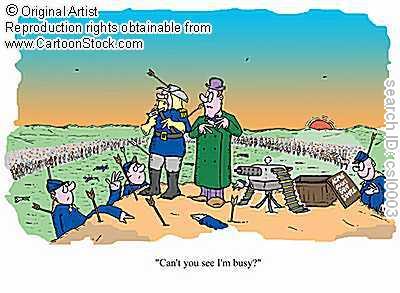
The Battle of the Little Bighorn, or Custer’s Last Stand, was a battle between combined forces of Lakota (Sioux), Northern Cheyenne and Arapaho against the United States Army’s 7th Cavalry Regiment. The battle took place on June 25 and June 26, 1876, near the Little Bighorn River in eastern Montana Territory, near what is now Crow Agency, Montana.
Led by Crazy Horse and Gall, and inspired by Sitting Bull (Tȟatȟáŋka Íyotake), the battle was part of the Great Sioux War of 1876–77 (also known as the Black Hills War). It was an overwhelming victory for the Lakota, Northern Cheyenne, and Arapaho. A force of 700 men led by George Armstrong Custer, had 268 deaths with 55 wounded. This was the last military victory obtained from a Native American tribe.
Major conflicts between Europeans and Native Americans lasted from 1492 (Landing of Christopher Columbus) to 1890 (Battle of Wounded Knee). There were numerous deaths on both sides. The primary cause of the conflicts was land and resources. The end result is that Native Americans were forced to move to reservations delegated by the United States government.
Gettysburg National Military Park, The Battle of Gettysburg - 1863
Gettysburg National Military Park, The Battle of Gettysburg - 1863
Gettysburg National Military Park
1195 Baltimore Pike
Gettysburg, PA 17325
(717) 334-1124

The Battle of Gettysburg (July 1-3, 1863) was the turning point in the Civil War. The Union victory here at Gettysburg forced General Robert E. Lee back into Virginia. It was the bloodiest battle of the American Civil War with 51,000 casualties. Many officers died in this battle which weakened General Lee’s ability to effectively wage future battles against the Union.
There is a museum and many monuments and memorials on location. See the actual location where President Abraham Lincoln said his now famous speech, “The Gettysburg Address.”
The Lewis and Clark Journey Timeline - 1805-1806
The Lewis and Clark Expedition - Meriwether Lewis and William Clark

The Lewis and Clark Expedition (1804–1806) was the first overland expedition by the United States to the Pacific Ocean and back. The expedition team was headed by United States Army soldiers Meriwether Lewis and William Clark with help by Sacajawea and Toussaint Charbonneau. The journey’s goal was to better understand the resources recently obtained through the Louisiana Purchase. The expedition laid much of the groundwork for the westward expansion of the United States.
Preparing for the Journey
• Monticello, Charlottesville, VA
• Harpers Ferry National Historical Park, West Virginia, Virginia, Maryland
• American Philosophical Society Hall, Philadelphia, PA
• Big Bone Lick State Park, Union, KY
• Old Clarksville Site, Clarksville, Indiana
• Fort Massac Site, Metropolis, Illinois
The Expedition
ILLINOIS
• Old Cahokia Courthouse, Cahokia
MISSOURI
• Jefferson National Expansion Memorial National Historic Site, St. Louis
• St. Charles Historic District, St. Louis
• Tavern Cave, St. Albans
• Rocheport Historic District, Rocheport
• Arrow Rock, Saline County
• Fort Osage, Sibley
NEBRASKA
• Leary Site, Rulo
• Fort Atkinson, Fort Calhoun
IOWA
• Sergeant Floyd Monument, Sioux City
SOUTH DAKOTA
• Spirit Mound, Vermillion
NORTH DAKOTA
• Knife River Indian Villages National Historic Site, Stanton
• Big Hidatsa Village Site, Stanton
• Fort Union Trading Post National Historic Site, Williston
MONTANA
• Lewis and Clark Camp at Slaughter River, Missouri River
• Great Falls Portage, Great Falls
• Tower Rock, Cascade
• Three Forks of the Missouri, Three Forks
• Beaverhead Rock-Lewis and Clark Expedition, Dillon
• Lemhi Pass, (also in Idaho)
• Clark’s Lookout, August 13, 1805, Dillon
• Traveler’s Rest, Lolo
• Lolo Trail (also in Idaho), Lolo
• Nez Perce National Historical Park (also in Idaho), Wisdom
• Pompey’s Pillar (return trip), Yellowstone River
• Camp Disappointment (return trip), Browning
• Two Medicine Fight Site (return trip), Cut Bank
IDAHO
• Lemhi Pass (also in Montana)
• Lolo Trail (also in Montana), Weippe Prairie
• Weippe Prairie, Spalding
• Nez Perce National Historical Park (also in Montana), Spalding
OREGON
• Rock Fort Campsite, The Dalles
• Fort Clatsop National Memorial (winter of 1806), Astoria
WASHINGTON
• Cape Disappointment Historic District, Ilwaco
• Chinook Point, Chinook
• Lewis & Clark Trail-Travois Road, Pataha Creek
After The Expedition
• Locust Grove, Louisville, Kentucky
• Natchez Trace Parkway, Nashville, Tennessee to Natchez, Mississippi
Source: http://www.nps.gov/nr/travel/LewisandClark/sitelist.htm
US Flag History, United States Flags Timeline - 1777-1960
US Flag History, United States Flags Timeline - 1777-1960
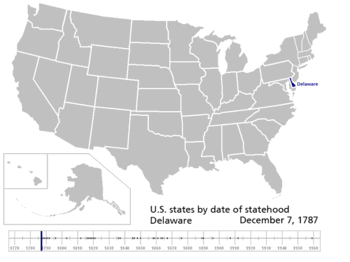
1777 - 13 Stars

Delaware, Pennsylvania, New Jersey, Georgia, Connecticut, Massachusetts, Maryland, South Carolina, New Hampshire, Virginia, New York, North Carolina, Rhode Island
1795 - 15 Stars

Vermont, Kentucky
1818 - 20 Stars
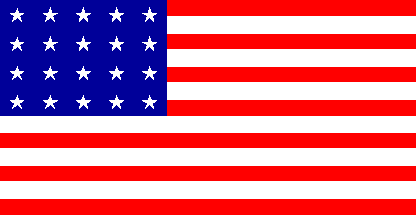
Tennessee, Ohio, Louisiana, Indiana, Mississippi
1819 - 21 Stars
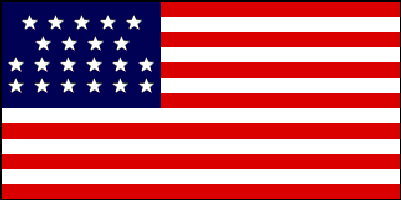
Illinois
1820 - 23 Stars

Alabama, Maine
1822 - 24 Stars
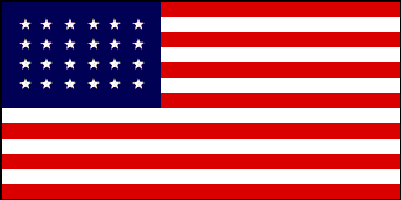
Missouri
1836 - 25 Stars

Arkansas
1837 - 26 Stars
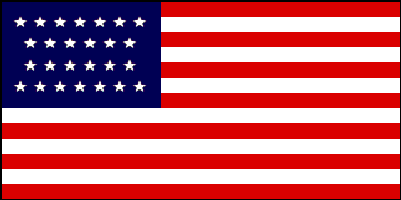
Michigan
1845 - 27 Stars
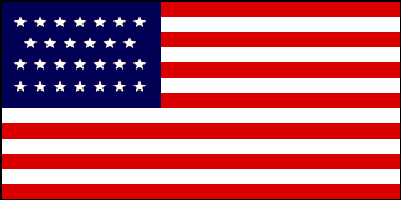
Florida
1846 - 28 Stars

Texas
1847 - 29 Stars
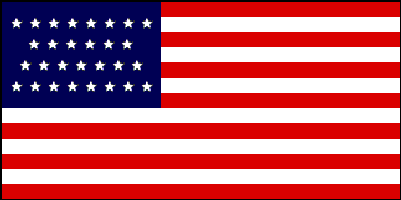
Iowa
1848 - 30 Stars

Wisconsin
1851 - 31 Stars

California
1858 - 32 Stars
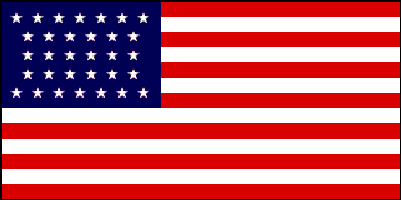
Minnesota
1859 - 33 Stars
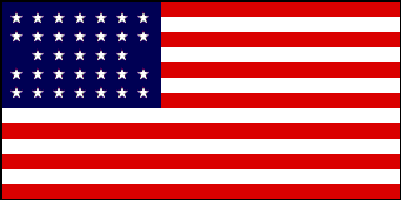
Oregon
1861 - 34 Stars
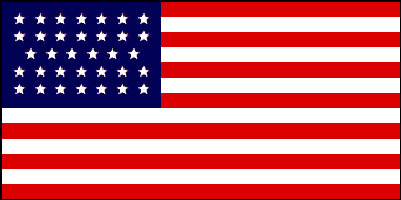
Kansas
1863 -35 Stars
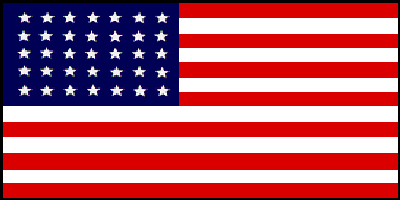
West Virginia
1865 - 36 Stars
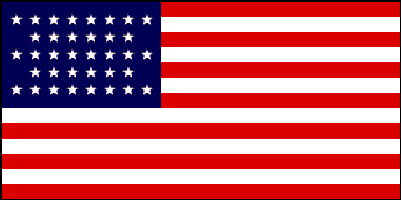
Nevada
1867 - 37 Stars
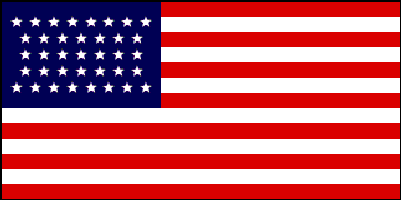
Nebraska
1877 - 38 Stars
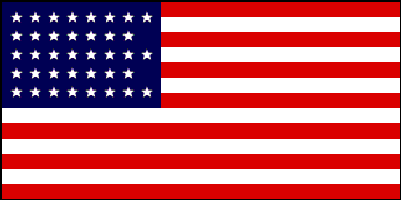
Colorado
1890 - 43 Stars
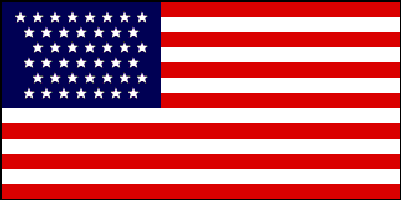
North Dakota, South Dakota, Montana, Washington, Idaho
1891 - 44 Stars

Wyoming
1896 - 45 Stars
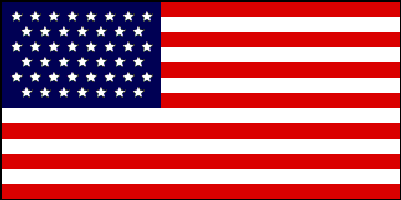
Utah
1908 - 46 Stars
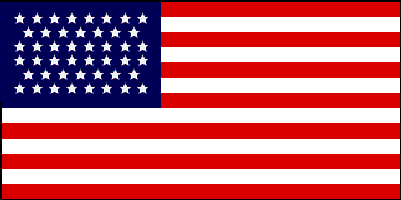
Oklahoma
1912 - 48 Stars
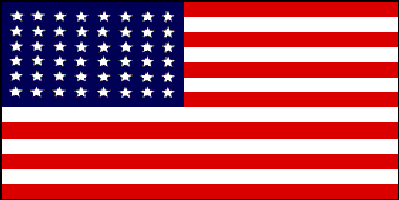
New Mexico, Arizona
1959 - 49 Stars
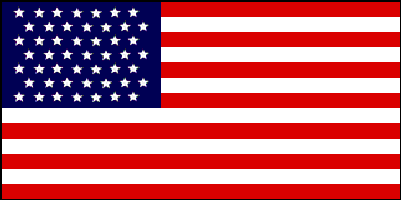
Alaska
1960 - 50 Stars

Hawaii
Valley Forge National Historical Park - Winter 1777-1778
Valley Forge National Historical Park
1400 N Outerline Dr
King of Prussia, PA 19406

Valley Forge National Historical Park is the location of the 1777-78 winter encampment of the Continental Army under General George Washington. Recruited by Benjamin Franklin in Paris, Baron Friedrich Wilhelm von Steuben, former member of the Prussian General Staff, prepared the Continental Army to fight more effectively against the British Army. Although the Winter of 1777-1778 was harsh and meager, it was a turning point in the American Revolutionary War. At the Battle of Barren Hill (May 20, 1778) and the Battle of Monmouth (June 28, 1778), the Continental Army stood up to the British Army on equal footing began to wear away at the morale of the British citizenship.
Mount Vernon Memorial Park VA, Home of George Washington
Mount Vernon Memorial Park VA, Home of George Washington
Mount Vernon Ladies’ Association
Address: PO Box 110, Mount Vernon, VA 22121
Phone: 703-780-2000
Hours: Open Every Day


Mt Vernon was the house where George Washington lived. During his life, Mount Vernon was an 8,000-acre plantation with overseers, slaves, livestock, equipment and buildings. The property also contained a forest that bordered the property, rolling meadows, serpentine walkways, a pleasure garden, a kitchen garden and groves of trees. Between the Mansion and the shores of the Potomac River lay an extensive park. Over the past 150 years, George Washington’s architectural achievements at Mount Vernon have been painstakingly preserved and restored for visitors to appreciate.
A visit to Mount Vernon begins at the Ford Orientation Center where a 20-minute movie, We Fight to Be Free, is shown. The film depicts George Washington at pivotal moments in his life.
Mt Vernon is George Washington’s home filled with 18th-century antiques, many of them owned by Washington. The Mansion house sits high above the Potomac River with a view of the Maryland shore.
50 acres of the estate are open to the public. Four gardens showcase heirloom plants known to have been at Mount Vernon in the late 1700s. George Washington designed the landscape which includes 13 trees that stand today as the last living witnesses of his life.
The Donald W. Reynolds Museum and Education Center opened on October 27, 2006. 23 theater and gallery experiences, many with interactive technology, tell the detailed story of George Washington’s life, including his military and political careers.
Directions to Mount Vernon by Car
Mount Vernon is located 16 miles south of Washington, D.C. and 8 miles south of Old Town Alexandria, Virginia at the southern terminus of the George Washington Memorial Parkway. Parking is free. There are spaces for RVs, motor coaches and trailers.
Street address: (use for mapping only, not a valid postal address)
3200 Mount Vernon Memorial Highway, Mount Vernon, Virginia 22309
 Directions From the North (Frederick, Gaithersburg, Rockville, Bethesda)
Directions From the North (Frederick, Gaithersburg, Rockville, Bethesda)
Travel south on I-270 to I-495. Follow I-495 south to Virginia. As you cross the American Legion Bridge over the Potomac River, get in the right lane. Take the first exit in Virginia, marked George Washington Memorial Parkway. Follow the George Washington Parkway south for about 30 miles, which takes you directly to Mount Vernon.
Directions From the South (Woodbridge, Richmond, North Carolina)
Travel north on I-95 and turn off at exit 161, Route 1 North, marked Ft. Belvoir/Mt. Vernon. Continue north on Route 1 about 6 miles, through Ft. Belvoir. Just after Ft. Belvoir, turn right on Route 235 north. Mount Vernon is three miles straight ahead, at a large traffic circle.
Plymouth Rock, Pilgrim Memorial State Park - 1620
Plymouth Rock, Pilgrim Memorial State Park, Mayflower II
Address: near 70 Water St, Plymouth MA 02360
Phone: 508-747-5360
Hours: Always Open


Pilgrim Memorial State Park - Plymouth Rock
Overview
Nearly one million people a year travel from all over the world to see Pilgrim Memorial State Park, which is one of the most heavily visited parks in the Massachusetts state parks system. In 1620, Europeans first made a home in New England. This simple glacial erratic boulder on the shore of Plymouth Harbor has become a world famous symbol of the courage and faith of the men and women who founded the first New England colony. A landscaped waterfront park provides scenic views of Plymouth Harbor.
History
In 1774, the rock split in two when a team of oxen attempted to raise it. Only the upper portion of Plymouth Rock left the waterfront originally for display in the Town Square. Souvenir seekers caused further deterioration until Plymouth Rock was moved to safety inside an iron fence at the Pilgrim Hall Museum in 1834. It had a rough trip to the museum, though, falling off its conveyance and obtaining its distinctive crack. The Pilgrim Society acquired the other half of Plymouth Rock in 1859, and in 1867, a Plymouth Rock canopy structure was completed at the waterfront to house it. In 1880, the upper chunk was united with the lower piece of Plymouth Rock with cement, and “1620″ was permanently carved into the rock. Plymouth Rock was moved for the last time during the celebration of Plymouth’s tercentenary in 1921 to a new canopy.

Mayflower II, a replica of the ship that brought the first Pilgrims to Massachusetts, is anchored at the park. Pilgrim Memorial State Park has an 81 foot granite monument that memorializes Plymouth Rock and provides the history of Plymouth Rock and Plymouth, MA.
Park Directions
Pilgrim Memorial State Park is located in southeastern Massachusetts. From north or south: Rte. 3 to Rte. 44 (Plymouth). Follow 44 east to waterfront. There is on-site parking.


